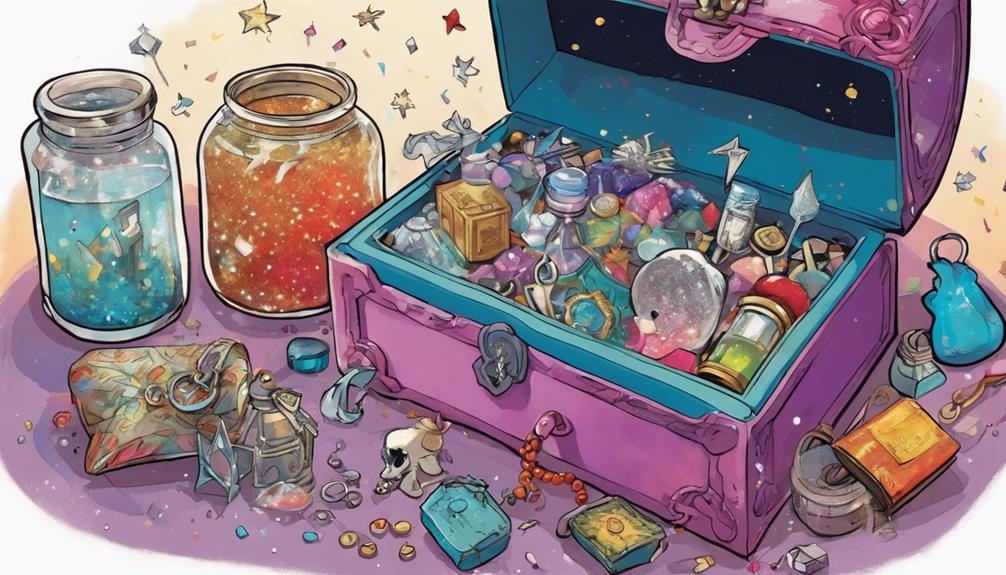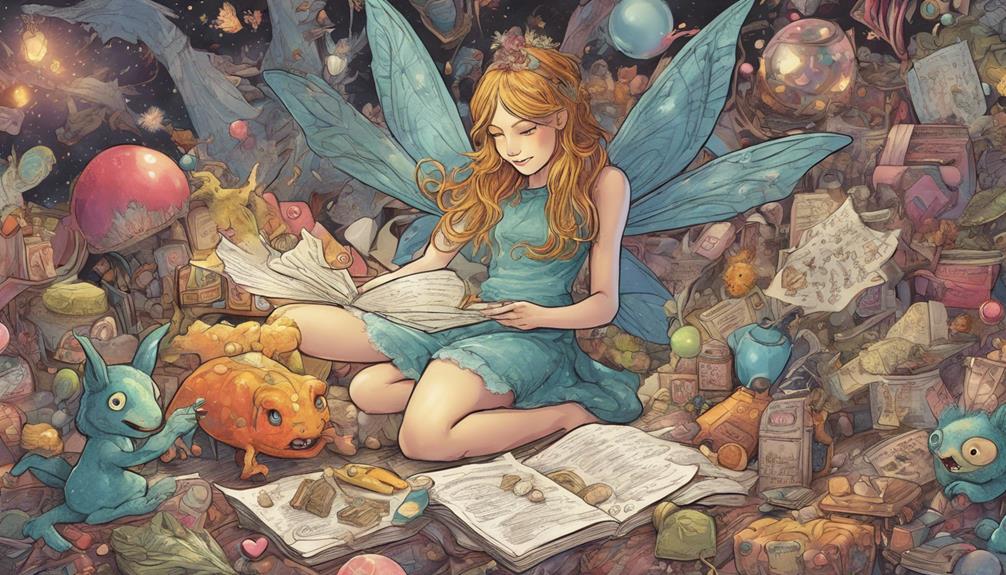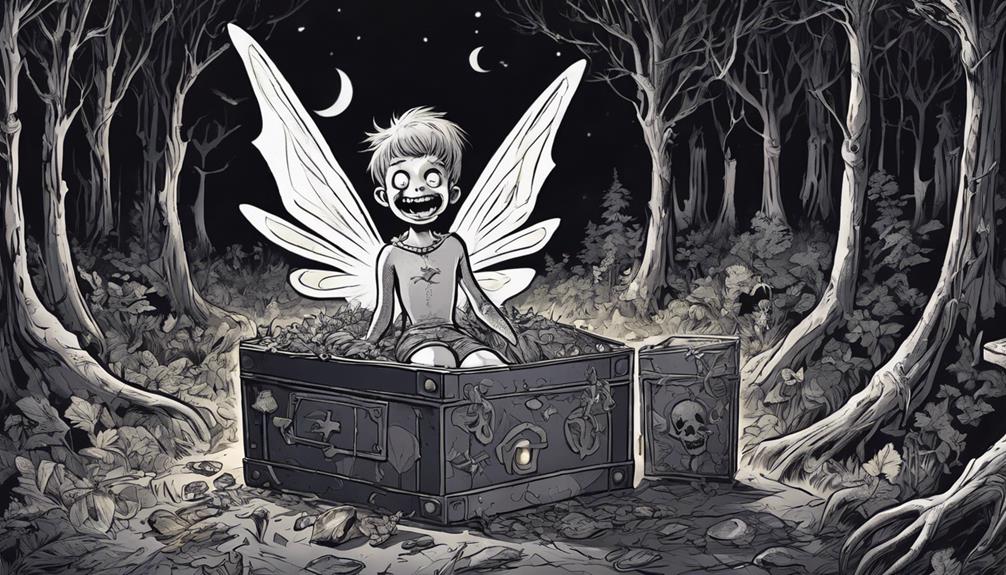When your child loses a tooth and places it under their pillow, it sparks more than just excitement. Across cultures, these tiny teeth commence enchanting journeys. In the U.S., the Tooth Fairy collects them, leaving coins in return, while in Spain, Ratoncito Pérez swoops in for a surprise. Some cultures even have unique rituals, like tossing teeth onto roofs for luck. Whimsical tales suggest fairies build castles from collected teeth or craft fairy dust. The next time a tooth goes missing, remember, there's a whole world of magic involved that you might find intriguing.
Key Takeaways
- The Tooth Fairy is believed to collect teeth to build castles in clouds and create magical fairy dust.
- Some whimsical theories suggest that teeth bloom into enchanted flowers in a secret fairy garden.
- Cultural variations exist, with traditions such as Ratoncito Pérez in Spain collecting teeth for community celebration.
- The collected teeth may be stored in a tooth museum, showcasing unique teeth from children throughout history.
The Origin of Tooth Fairy Tales

The enchanting tradition of the Tooth Fairy has roots that trace back to ancient customs surrounding the loss of baby teeth. In various cultures, losing a tooth symbolized a change, often linked to childhood innocence and growth. You might be surprised to learn that many societies had their unique rituals to celebrate this milestone.
For example, in some traditions, parents would bury lost teeth in the ground, believing it would help the child grow strong and healthy. Others would toss the teeth into a fire, signifying a transformative act and keeping negative spirits at bay. These practices reflected a common desire to honor the rite of passage associated with losing baby teeth.
As time passed, the whimsical figure of the Tooth Fairy emerged, blending these customs into a more playful narrative. Instead of burying or burning teeth, children began to leave them under their pillows, anticipating a visit from this magical being.
You might find it fascinating how this evolution transformed the loss of teeth into a fun and imaginative experience, one that continues to bring joy to children today. The Tooth Fairy, fundamentally, represents not just a fairy tale, but a celebration of growing up.
Cultural Variations of Tooth Collectors

When you think about tooth traditions around the world, you'll find a rich tapestry of rituals and beliefs.
Each culture has its unique way of celebrating the loss of a tooth, often filled with symbolism that reflects their values.
Let's explore these fascinating variations and what they mean for families everywhere.
Global Tooth Traditions
Across the globe, various cultures celebrate the loss of teeth with unique traditions, each adding its own twist to the age-old practice of tooth collecting.
In the United States, children enthusiastically await the arrival of the Tooth Fairy, who exchanges a lost tooth for a small gift or money. Meanwhile, in Spain and parts of Latin America, children look forward to the 'Ratoncito Pérez,' a little mouse that collects teeth, often leaving a surprise in return.
In some cultures, like those in many Asian countries, the lost tooth is tossed onto the roof or buried in the ground. This act symbolizes good luck and encourages the growth of strong, healthy teeth.
In India, children often place their lost teeth under their pillows, but the tradition varies by region. Some believe in a special ceremony to honor the tooth before it's collected.
These diverse customs reflect how different cultures perceive childhood milestones and the significance of teeth. Regardless of the tradition, the excitement surrounding the loss of a tooth remains universal, creating cherished memories that children carry into adulthood.
Unique Rituals Explained
Many cultures have their own unique rituals for collecting lost teeth, each adding a special flair to this cherished childhood experience.
In Spain and some Latin American countries, kids often toss their lost teeth onto the roof, believing this act will invite the Tooth Fairy or a mouse to bring them gifts. In contrast, children in India may bury their teeth in the ground, hoping for strong and healthy replacements to grow in their stead.
In Japan, a child might throw their lower teeth onto the roof and their upper teeth into the ground, symbolizing growth and balance. Meanwhile, in Turkey, it's common for kids to place their lost teeth under their pillows, where they await a visit from a magical mouse who leaves a small reward.
In many Middle Eastern nations, parents often hold a special ceremony to celebrate the loss of a tooth, making it a communal event.
These rituals illustrate how the experience of losing a tooth is transformed into an opportunity for creativity and cultural expression, fostering a sense of wonder and excitement for children across the globe.
Symbolism in Cultures
The symbolism behind tooth collectors varies widely, reflecting each culture's unique beliefs and values surrounding childhood and growth.
In Western cultures, the Tooth Fairy embodies the shift from childhood to maturity, celebrating the loss of teeth as a rite of passage. You might place your lost tooth under your pillow, enthusiastically awaiting a small reward, symbolizing the end of one phase and the start of another.
In contrast, some cultures have different customs. In Spain and many Latin American countries, children often leave their teeth under their pillows for Ratoncito Pérez, a mouse who collects teeth and rewards them. This replaces the fairy with a more relatable figure, emphasizing community and tradition.
Meanwhile, in parts of Asia, children might throw their lost teeth onto rooftops or into the ground, each act carrying its own significance. This practice often symbolizes good luck or the hope for stronger teeth in the future.
The Science Behind Baby Teeth

Baby teeth, also known as primary teeth, play an essential role in your child's oral development, guiding the way for permanent teeth to emerge. These temporary teeth usually start to appear around six months of age and continue to come in until about three years old.
As a parent, you might wonder how many baby teeth your child will have. Here's a quick breakdown:
| Age Range | Primary Teeth Eruption | Total Baby Teeth |
|---|---|---|
| 6 – 12 Months | Central incisors | 4 |
| 12 – 18 Months | Lateral incisors | 8 |
| 18 – 24 Months | Canines | 12 |
| 24 – 36 Months | Molars | 20 |
These baby teeth help with chewing and speaking, but they also reserve space in the jaw for the adult teeth that will follow. When it's time for them to fall out, usually around age six, the roots dissolve, allowing for a smooth shift to permanent teeth. Keeping your child's baby teeth healthy is vital for their overall dental health as they grow.
Whimsical Theories and Speculations

Whimsical theories about the Tooth Fairy abound, sparking imagination and curiosity in both kids and parents alike. Some believe that the Tooth Fairy collects teeth to build magical castles in the clouds, using them as sparkling bricks. Others speculate that she's creating a special tooth museum, showcasing all the unique teeth collected from children around the world.
You might consider the theory that the Tooth Fairy uses the teeth to craft her very own fairy dust, making her powers even stronger. Perhaps there's a secret fairy garden where she plants the teeth, allowing them to blossom into enchanted flowers.
Another fun idea is that the Tooth Fairy has a team of tiny assistants who help her in her nightly quest, each with their unique job. Some might be responsible for collecting the teeth, while others guarantee the perfect exchange of coins.
You could even imagine that the Tooth Fairy travels through time, gathering teeth from children throughout history, preserving them as a symbol of childhood innocence.
These whimsical theories add a sprinkle of magic to the tradition, encouraging kids to dream and wonder about the mysteries behind losing their teeth.
The Tooth Fairy Economy

When your child loses a tooth, you might wonder about its value in the Tooth Fairy economy. The amount you leave under the pillow can influence not just your child's excitement, but also how families perceive this little tradition.
Let's explore how this tooth trade affects family finances and the broader economic picture.
Tooth Trade Value
The Tooth Fairy economy thrives on the mysterious exchange of lost teeth for coins, creating a unique trade value that fascinates children and parents alike. When your child loses a tooth, it's not just a rite of passage; it's also an opportunity for them to engage in this whimsical transaction.
As you navigate the Tooth Fairy tradition, you might notice several factors that influence the trade value of those precious teeth.
- Geographic Location: The amount left under the pillow often varies by region, with some areas offering more than others.
- Market Trends: Just like any economy, the Tooth Fairy's offerings can fluctuate based on trends. You might see an increase in value if many kids are losing teeth simultaneously.
- Parental Influence: Sometimes, parents set the stage for what the Tooth Fairy leaves based on their own childhood experiences or financial considerations.
- Special Occasions: A lost tooth around holidays or birthdays might garner a higher payout, making it a memorable event for your child.
This whimsical economy captures imaginations and creates lasting memories!
Economic Impact on Families
Participating in the Tooth Fairy economy can subtly impact your family's budget, especially when multiple children are losing teeth around the same time. The cost of each tooth can add up quickly, particularly if your kids are expecting a generous payout. The average amount a Tooth Fairy leaves has been rising, which means you might need to adjust your spending accordingly.
Here's a quick breakdown of how much families typically spend on teeth:
| Tooth Fairy Payout | Number of Teeth Lost | Total Cost |
|---|---|---|
| $1 | 1 | $1 |
| $5 | 2 | $10 |
| $10 | 3 | $30 |
As you can see, the Tooth Fairy economy can become quite significant. You might find yourself budgeting for those little surprises, especially when kids share their stories about how much their friends received. This playful tradition can strain your finances if you're not careful. So, consider setting a consistent rate for each tooth to keep the magic alive without breaking the bank.
Environmental Impact of Lost Teeth

Often overlooked, the environmental impact of lost teeth raises important questions about dental waste and its contribution to pollution. When you consider the disposal methods of these tiny treasures, you might realize the potential effects on our planet.
First, you should think about how teeth are often discarded. Many parents toss them in the trash, leading to increased landfill mass.
Second, consider the materials used in dental treatments. Fillings and crowns can contain metals like mercury, which can leach into the environment when disposed of improperly.
Third, the production of dental products contributes to environmental degradation. From toothpaste tubes to floss packaging, these items often end up in landfills, adding to plastic pollution.
Finally, when teeth are incinerated, they can release harmful chemicals into the air, affecting air quality and public health.
Understanding these aspects can help you make more informed choices about dental care and disposal. By being aware of the environmental consequences, you can play a part in reducing dental waste and protecting our planet for future generations.
Keeping the Magic Alive

Creating a memorable Tooth Fairy experience can spark joy and wonder in your child's imagination. To keep the magic alive, you can craft a special bedtime routine when your child loses a tooth. Encourage them to place the tooth under their pillow, and help them write a little note to the Tooth Fairy, expressing their excitement. This personal touch makes the experience feel unique.
You might also consider creating a special Tooth Fairy pouch or pillow that adds an element of surprise. A designated spot makes it more thrilling when the Tooth Fairy visits. When your child wakes up, be sure to act surprised and excited about the Tooth Fairy's visit, reinforcing the magic.
Additionally, you can leave small tokens or notes from the Tooth Fairy to enhance the experience. Maybe it's a glittery coin or a small toy that relates to your child's interests. These little gestures turn a simple tooth exchange into a cherished memory.
Frequently Asked Questions
What Do Parents Tell Children About the Tooth Fairy's Existence?
Parents often create enchanting stories about the tooth fairy, assuring you that she collects lost teeth in exchange for gifts. They weave tales of magic, encouraging your imagination and making the experience special and memorable.
How Do Different Cultures Celebrate Losing Baby Teeth?
Isn't it funny how losing teeth sparks such creativity? In some cultures, kids toss teeth onto roofs, while others bury them or toss them into rivers, each with unique beliefs about good luck and growth.
Are There Any Historical Figures Related to the Tooth Fairy?
You might find it interesting that while the Tooth Fairy is largely a modern concept, ancient traditions, like Norse customs, involved burying teeth for good luck. Historical figures aren't directly linked, but cultural practices shaped the fairy's story.
What Age Do Children Typically Stop Believing in the Tooth Fairy?
Typically, children stop believing in the Tooth Fairy around ages 6 to 8. You'll notice they start questioning the magic as they grow older, often influenced by their peers and a desire for more realistic explanations.
How Can Parents Make Losing Teeth More Exciting for Kids?
To make losing teeth exciting, you can create a celebration ritual. Use fun stories, special keepsake boxes, or even a little treasure map to enhance the experience. Your enthusiasm will make it memorable for your child!
What Happens to the Teeth Once the Tooth Fairy Collects Them?
After a child’s tooth fairy experience, the collected teeth are said to be taken to a magical land where they are used to build the fairy’s castle. Some believe the teeth are used as currency, while others think they are transformed into the stars that light up the night sky.
Conclusion
In a world where childhood wonder thrives, the Tooth Fairy remains a cherished figure, sparking imaginations and traditions across cultures.
As you reflect on the fate of those tiny teeth, isn't it fascinating to contemplate the blend of science and whimsy that surrounds this age-old practice?
By embracing the magic while being mindful of the environmental impact, you can help keep the enchantment alive for future generations, ensuring that the Tooth Fairy's legacy continues to sparkle.









